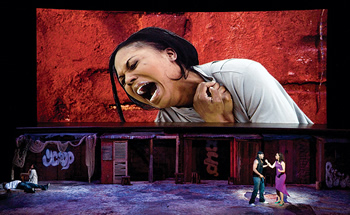
Workshopping Edinburgh
By Minou Arjomand
The theme of the Edinburgh International
Festival this year was "Oceans Apart": an exploration of relationships
between the Old World and the New. I travelled to Edinburgh as
the New World's sole delegate at a workshop program held parallel
with the festival. This workshop was part of the Deutsche Bank
Foundation's "Akademie Musiktheater Heute," a two-year series
of workshops for young professionals in opera (composers, directors,
conductors, dramaturgs, set designers, and--as the Germans call
them--Kulturmanagers). An American, I was there as a
dramaturg. All of the other fellows lived in German-speaking European
countries; most were born in Germany.
Shuttling back and forth to various workshops
over the past few years, it has struck me that the salient differences
across the Atlantic weren't so much in the theater itself, but
in how people talk about and evaluate theater. One difference
was brilliantly articulated by the conductor Pinchas Steinberg
during a workshop at the Teatro Real in Madrid this June. Referring
to musicians, Steinberg said that in his 40 years of experience
there had been one major difference between American and European
orchestras. When American instrumentalists encounter a passage
they have difficulty playing, they always play softer. When Europeans
do, they play as loudly as they can. The observation runs counter
to the stereotype of American brashness and volume, yet it was
borne out for me in all of our workshop sessions.
During many of our discussions, the level
of vitriol and frequency of interruptions were on par with Tea
Party town halls, even though the stakes of the arguments often
seemed petty. This hostility may have come in part from the rigidly
hierarchical structures of German opera houses, perhaps in part
from the doom that tended to hover over our conversations about
the future of opera with German directors. When I applied to the
program, I was asked to write an essay about how to save opera
from its current "crisis" (the nature of the crisis was unspecified).
After we saw his production of Samuel Beckett and Morton Feldman's
opera Neither, Peter Mussbach told us: "I really don't
know what your generation is going to be able to do that hasn't
already been done: in a sense, I think that my production of Neither
really shows that we have come to the end of new possibilities
for theater."
On our first full day in Edinburgh we met
with Jonathan Mills, current director of the Edinburgh International
Festival. Mills immediately launched into a well-rehearsed presentation
of his interests in risk-taking and creative innovation. Along
the way he mentioned that his current thinking about the social
role of art was influenced by reading a book about neuroscience.
At this, a round-faced German dramaturg wearing a lavender and
green striped tie and a violet v-neck sweater interrupted him
mid-sentence: "You say that you are interested in taking
risks. Yet now you mention that you have been reading a book about
neuroscience."
The dramaturg, paused, scoffed, and paused
again as though to drive his jibe home, "And yeah, this sort of
positivist thinking, and especially neuroscience is very trendy
right now. But obviously we can all agree that it represents a
reactionary position, and not a very risky one. So, my question
would be that I'd like to hear more about your programming choices
and how they reflect risk."
He leaned back in his chair, manifestly
pleased with himself. Although Mills seemed as mystified about
the substance of the dramaturg's complaint as the rest of us,
the timbre of the comment left no doubt that it was intended as
a crippling insult. A quick hair sweep to the right, and Jonathan
Mills countered that programming a John Adams opera as the festival's
opening number was very risky indeed, and began to talk about
the project.
The dramaturg interrupted again: "Oh yeah,
the Christmas Oratorio, right?" Smirk.
"No." To be fair to the dramaturg,
it was, in fact, a Christmas Oratorio: El Niño, billed
in the program as giving "new life" to "the miracle of the nativity."
I was stunned when later that day, the same dramaturg remarked
to me that he was impressed by Mills and found his presentation
pretty convincing, on the whole. I couldn't imagine how the dramaturg
would address someone he didn't respect.
***
In Ill Fares the Land, Tony Judt
argues that we have forgotten how to ask questions. In the political
arena we no longer ask whether our actions are just, we ask for
the capital risk involved; we don't ask what a good society entails,
we ask about profit margins.
Something is profoundly wrong with the
way we live today … We know what things cost but have no idea
what they are worth. We no longer ask of a judicial ruling or
a legislative act: Is it good? Is it fair? Is it just? Is it
right? Will it help bring about a better society or a better
world? Those used to be the political questions, even if they
invited no easy answers. We must learn once again to pose them.
During our workshops, I grew discouraged
about our ability to ask questions about theater as well. Rather
than asking if the theater makes us and our societies better,
we Deutsche Bank fellows would ask: Is it new? Is it radical?
Does it look like it was produced without the intention of being
a commercial success? To his credit, Jonathan Mills did begin
our workshop by throwing out some of the right questions for a
festival director: What is a festival? How does it relate to its
social context? What does it mean to the community of audience-members?
But he raised all of these questions rhetorically. And once he
brought up risk, he had a difficult time trying to turn the conversation
away from risk as the sine qua non of respectable programming.
Part of the reason that questions about
social good were almost entirely absent from our hours of discussion
about contemporary theater may be that it was taken for granted.
State sponsorship of art has never been seriously questioned in
the countries where most of the fellows study and work. While
the public support of art in Germany would be a dream to many
of us in the States, it may also lead to a certain complacency
on the part of young artists who are not called upon to justify
their work in social terms. At the same time, it is hard to speculate
about what a parallel program with American fellows would be like:
avant-garde opera practice is hardly among the priorities of government
spending or corporate philanthropy in the United States.
In some ways, the twin theater festivals
in Edinburgh represent the funding models from each side of the
Atlantic. The Edinburgh International Festival and the Edinburgh
Fringe Festival were both born in 1947, when the homes of Europe's
other major festivals--Munich, Salzburg, Bayreuth--fallowed in
moral as well as physical decay. These former sites of European
artistic pilgrimage had spent a decade as vehicles for Nazi propaganda.
Half a century after the cities were rebuilt, the festivals haven't
recovered from their pasts. Hans Neuenfels's famous production
of Die Fledermaus at Salzburg sent its 200 euro-a-seat
paying audience into a tizzy by portraying them on stage as cocaine-snorting
Nazis. In the 2007 Bayreuth festival, Wagner's great-granddaughter
Katharine Wagner staged Hitler's favorite, Die Meistersinger.
The only coherent remarks most reviewers found to make were that
it was trying to say something about Hitler, and that
it got a lot of boos. Since assuming leadership of the Bayreuth
Festival, Katharine Wagner has asked academics to investigate
Bayreuth's ties to the Nazis, in particular the rumor that her
grandmother was Hitler's lover.
Free from this sort of compromised history,
Edinburgh offers a reprieve from the naval-gazing of much Teutonic
Regietheater. The International Festival in Scotland's city on
a hill was created to promote peace through a celebration of culture.
It was the first major transnational institution in postwar Europe
designed specifically to forge a collective European identity.
At the same time, the International Festival was hardly designed
as a democratic institution: it was traditionally led by a single
director who saw himself as the arbiter of European taste.
In contrast to the International Festival,
the Fringe is organized on the model of free-market anarchy. The
Fringe began when several theater companies arrived at the first
International Festival uninvited, and produced their shows simultaneously
with the official program. In the following years, more groups
followed their example, and in 1959 they created the Festival
Fringe Society. This Society has never instituted a selection
process. Any group who can pay for its transportation to the festival,
accommodations, production costs, the 250-pound registration fee,
and rent its own venue in Edinburgh, is welcome.
The International Festival is sometimes
accused of snobbery and importing experimental high budget productions
that have little to do with Scottish culture; the Fringe Festival
is sometimes accused of rabid commercialism and too much standup
comedy. Not that the International Festival isn't a commercial
venture itself: like other summer festivals around Europe it was
in part designed to increase tourism, and its role became increasingly
important as Scotland shifted from an industrial to a tourist-driven
economy in the late 20th century. Its success led to a proliferation
of Edinburgh festivals during the month of August, including the
Book Festival, Jazz Festival, Military Tattoo Festival, International
Television Festival, and the Festival of Politics.
***
Based on the shows that I saw during my
week in Edinburgh, it seems that the difference between the two
festivals is mostly one of scale. On our first night, we fellows
attended Porgy and Bess, co-produced by the Edinburgh
Festival and the Opera Lyon. Under William Eddins' leadership,
the orchestra sounded wonderful: he managed to keep Gershwin's
harmonic fineries from drowning in the brass section. The staging
departed from the usual period productions of this opera and introduced
dancers and a large video screen. The dancers, video, and staged
actions were often redundant. In the storm scene (from top down),
the screen showed a video of crashing waves, singers braced themselves
and sang about the crashing waves, dancers emulated waves. Often
the video used a green screen to simultaneously project exactly
what was happening on stage above the stage, except that the projection
included some close-ups and period details of Catfish Row.
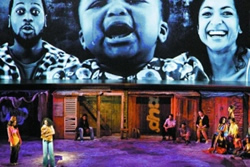 After
his death, Gershwin's estate stipulated that Porgy and Bess
could only be performed by an all-black cast. Gershwin had been
offered a commission by the Metropolitan Opera but turned it down
in order to write Porgy and Bess (it wasn't until 1955,
twenty years after its premiere, that a black singer first appeared
at the Met). While the opera did support the careers of the first
generation of African-American opera singers, Porgy's
folksy depiction of a rural black community is rife with racial
stereotypes. Most productions of it are far more conservative
than standard productions of Mozart or Verdi. The assumption remains
that only black opera singers can portray the happy, simple people
of Catfish Row.
After
his death, Gershwin's estate stipulated that Porgy and Bess
could only be performed by an all-black cast. Gershwin had been
offered a commission by the Metropolitan Opera but turned it down
in order to write Porgy and Bess (it wasn't until 1955,
twenty years after its premiere, that a black singer first appeared
at the Met). While the opera did support the careers of the first
generation of African-American opera singers, Porgy's
folksy depiction of a rural black community is rife with racial
stereotypes. Most productions of it are far more conservative
than standard productions of Mozart or Verdi. The assumption remains
that only black opera singers can portray the happy, simple people
of Catfish Row.
The choreographers who staged this production--José
Montalvo and Dominique Hervieu--seemed obsessed with visual authenticity.
They managed to throw in every possible visual marker of blackness:
costumes and choreography from Kris Kross music videos; brightly
colored graffiti tags on wooden fishing shanties from South Carolina
c. 1915; video clips of Martin Luther King Jr., civil rights marches,
and a burning car. Despite this preoccupation with signifying
blackness visually, though, the directors failed to convey Gershwin's
most obvious nod to historical and racial specificity: the dialect.
Aside from the few Americans in the cast, the accents were very
poorly done, as though the directors just assumed that being black
(whether French, British, or American) were enough to be able
to convincingly speak in the antiquated dialect of Gershwin's
libretto. No one else in the all-white audience seemed to notice
the incongruity. The location, era, and political message were
jumbled, but one thing was clear: these were black people. Porgy
and Bess was the biggest commercial success of the International
Festival.
Do we look like Refugees? by Beyond
Borders Productions Ltd. at the Fringe explored themes similar
to those of Porgy and Bess: how communities cope with
adversity, and what images, dialects, and intonations of voice
can convey individual experience across cultures. Director Alecky
Blythe recorded a series of interviews with refugees who lost
their homes in the 2008 Russian-Georgian War. Rather than transcribe
the interviews, Blythe gave each actor an audio recording. The
actors learned their lines by listening to the recordings, imitating
not only the words but the inflections of the voices (one of the
pleasures of this production was hearing Georgian … thankfully
with supertitles). The interviews themselves were well edited
and compiled, and had some amazing lines.
When you leave a house empty for more
than two years it goes cold. There is a Georgian curse, we say:
"May your house go cold." It becomes like an orphan
child with sad ears.
The gallows humor of the play made it a
pleasure to watch. One woman tells the interviewer that in the
refugee camps there are always weddings and new babies: "Even
couples who couldn't get pregnant before are having children.
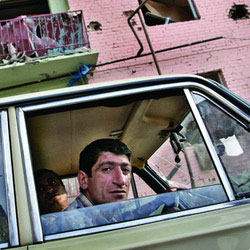 It
seems that God is regulating the demographic situation." Blythe's
decision to have her actors not only learn from the headphones
but also use them on stage created the tension between source
material and performance, artifice and authenticity that was missing
from Porgy and Bess. Despite the closeness of speech
to the original interviews, the headphones emphasized the Brechtian
distance between the actors and the people they were portraying.
It
seems that God is regulating the demographic situation." Blythe's
decision to have her actors not only learn from the headphones
but also use them on stage created the tension between source
material and performance, artifice and authenticity that was missing
from Porgy and Bess. Despite the closeness of speech
to the original interviews, the headphones emphasized the Brechtian
distance between the actors and the people they were portraying.
While Do We Look Like Refugees?
included a great deal of cultural specificity, it did not claim
to portray the souls of the people. In one episode, the interviewee
briefly speaks in mundane terms about her work. Then she asks
the interviewer what the interview is for, finds out that it is
for a theater piece that will play for international audiences,
and begins to pontificate on the beauty of Georgia and cite national
poets in elevated terms. At the same time as Blythe and her actors
explore Georgian identity, they also show how contingent this
identity is on political ambitions and circumstances.
***
Organizing each year's programming around
a theme has been one of Mills's innovations to the festival, and
it is linked to his desire to broaden the Festival's traditional
focus on European theater. In an interview with Simon Thompson
for Musicweb International, Mills explained:
While I have attempted to argue that
this Festival need not be so Eurocentric, I haven't attempted
to do so in a nationalistic way by saying, for example, "This
year we're focusing on China, next year on Iceland or Romania."
Instead I've tried to construct a more multi-faceted approach
to the theme underpinning each festival journey. This year I've
said that I'm interested in looking at a particular region,
not a single country, and an idea of how that relationship between
worlds might express itself from both positions.
This position is compelling--I only found
myself wishing that the theme were more clearly articulated: had
Mills not told us about the theme during our discussion, I wouldn't
have realized there was one.
There was no headline about the theme in
the festival program. Instead, it appeared in 12-point font in
Mills's brief introductory text. He wrote that the motto "Oceans
Apart" conjured "images of the harsh physical journeys across
huge expanses of sea, taken at great peril by European explorers
from the 14th century, in search of new worlds. They also suggest
the often brutal suppression wrought by colonial invasion. But
most of all, I hope that they suggest an expansive imaginative
territory between places of extraordinary cultural diversity which
this programme seeks to explore and even to bridge." This text
throws a sentence of victimhood to both the oppressors and oppressed,
but trumps any historical or political specificity with a blanket
celebration of hybridity. I was a bit thrown off when during our
workshop Mills told us that "as a former colonial himself " he
felt comfortable confronting issues that perhaps his British counterparts
might avoid. If the Festival Director didn't recognize the difference
between a contemporary white Australian and the victims of 14th-century
colonialism, it boded poorly for the Festival. None of the descriptions
of individual productions in the program referenced the overarching
theme, and the criteria for the selections seemed to be simply
that the artists came from a historically colonized and/or colonizing
country. In other words, the theme of the Edinburgh International
Festival was simply that it was international.
I do think that the program was a good-faith
attempt on the part of Mills to promote conversation about social
and political issues among audience members. The Festival did
include a short series of panels and lectures, some of which were
about colonialism. But these events weren't free for people who
had seen the performances (they cost £6.50--more than most Fringe
shows), so audience members had to buy tickets to two separate
events to get both the art and the social dialogue. One could
certainly sympathize with the difficulty of combining a narrowly
defined theme with high-quality programming in such a large festival.
At the same time, claiming to the media (and indeed, to workshop
participants skeptical of your subversive cred) that the festival
tackled a political theme like colonialism when it actually presented
an apolitical mix of multicultural fare was irresponsible.
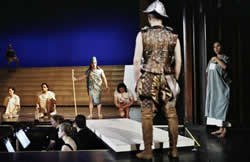 Of
the productions, one of the few explicitly about colonialism was
the 18th-century opera Montezuma composed by Carl Heinrich
Graun to a libretto by his benefactor, Friedrich II of Prussia.
The Enlightened monarch felt sympathy for the Aztecs--or at least
antipathy toward the conquistadors--and began his libretto with
expositions of Montezuma's justice and enlightenment. Montezuma
is too trusting, though; he is tricked by Cortés and dies in the
final act.
Of
the productions, one of the few explicitly about colonialism was
the 18th-century opera Montezuma composed by Carl Heinrich
Graun to a libretto by his benefactor, Friedrich II of Prussia.
The Enlightened monarch felt sympathy for the Aztecs--or at least
antipathy toward the conquistadors--and began his libretto with
expositions of Montezuma's justice and enlightenment. Montezuma
is too trusting, though; he is tricked by Cortés and dies in the
final act.
Director Claudio Valdés Kuri staged the
first half of the opera as an ironic presentation of how the West
viewed the Aztecs: before the opera began, vendors with tourist
trinkets advertized their wares to the audience. During the opera,
the Aztecs dressed savage-kitsch. Montezuma sang half naked throughout,
though at one point--for no discernable reason--put on a tourist
T-shirt, removing it several minutes later. It was unclear whether
the technical problems with the staging were also meant ironically.
I think not. When the first conquistador, Captain Narvès, appeared
on stage, he brought with him a German Sheppard, who barked whenever
Narvès sang to show the captain's ferocity. Rather than barking
at Montezuma, though, the dog stared down into the pit (from my
angle, at the crotch of an extremely uncomfortable-looking bassist),
where a stage hand was obviously waving something to make him
bark. During one scene, the natives had built up pyramids with
jenga blocks. To symbolize the destruction of the civilization,
Narvès threw a plastic Coca-cola bottle at the fragile pyramids.
The bottle fell just short, hit the ground, and bounced over the
pyramids leaving them unscathed. Montezuma sang the last act on
top of a column with a very obvious safety harness around him.
When he flung himself from the top, the whirring of the harness
as it gently deposited him on the ground out-hummed the music.
Even when there weren't technical problems,
the opera was difficult to watch. Narvès appeared in the second
half with a sack full of Coke bottles. As the Aztecs ambled in
a circle with water bottles between their legs, the conquistador
assaulted them one by one and replaced the water bottles with
Coke as the natives mimed castration. As in Porgy and Bess,
overdetermination was the name of the game. Towards the end, there
was one compelling moment, when the music stopped and the conductor
Gabriel Garrido handed out new music to the singers, connecting
the missionary work of imperial Spain with the Western classical
tradition. This reprieve from the general tastelessness of the
production, however, couldn't do much to redeem it. During the
curtain call the German dramaturg fellow, who was now wearing
a dark purple tie with a light purple sweater, turned to me: "Now
that was Eurotrash."
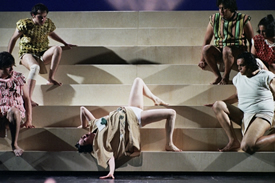 If
the political shallowness of the staging was irritating, the treatment
of the female lead was infuriating. During Lourdes Ambriz's first
aria as Eupoforice, she was stripped and left in a ridiculous
bodysuit with uneven pom-poms over her nipples and a blindfold
over her eyes. As she sang, she shakily made her way along a narrow
catwalk between the orchestra and audience in 5-inch heels (a
symbol of Western oppression). She sang a later aria lying upside
down on a staircase, slowly moving up the steps as she sang. This
was far from the first production I've seen where the director
exploits women on stage under the pretense of showing the audience
how women are exploited in society; Catalonian director Calixto
Bieito has made a career of it. While singers often have no choice
but to follow their directors or risk their careers, it is unfortunate
that festivals and opera houses condone this sort of misogyny
and even think of it as edgy and politically progressive.
If
the political shallowness of the staging was irritating, the treatment
of the female lead was infuriating. During Lourdes Ambriz's first
aria as Eupoforice, she was stripped and left in a ridiculous
bodysuit with uneven pom-poms over her nipples and a blindfold
over her eyes. As she sang, she shakily made her way along a narrow
catwalk between the orchestra and audience in 5-inch heels (a
symbol of Western oppression). She sang a later aria lying upside
down on a staircase, slowly moving up the steps as she sang. This
was far from the first production I've seen where the director
exploits women on stage under the pretense of showing the audience
how women are exploited in society; Catalonian director Calixto
Bieito has made a career of it. While singers often have no choice
but to follow their directors or risk their careers, it is unfortunate
that festivals and opera houses condone this sort of misogyny
and even think of it as edgy and politically progressive.
Although I have never seen an effective
ironic staging of an opera (I have seen many attempted), I can
understand why the director decided on a tongue-in-cheek production
of Montezuma. I sympathize that we can't represent the
Aztecs on an opera stage without borrowing colonialist clichés,
as well as with the decision to prevent the audience from feeling
comfortable in their position as spectators. Comfort and knowing
condescension can certainly go hand in hand in productions hyped
for their multiculturalism. But there are better ways to confront
audiences than tacky costumes and a countertenor flapping his
penis around the stage.
Tempest: Without a Body was not
an opera, but it was far more effective in its negotiation between
colonial assumptions and indigenous tradition. Choreographer Lemi
Ponifasio named his company Mau after the Samoan independence
movement, and has designed it as a transnational institution bringing
together the performance practices and political activism of Pacific
peoples. The group has toured extensively and its production Requiem
was performed at the Lincoln Center Festival in 2008. Tempest
presents elements of Shakespeare's play alongside the biography
of Maori activist Tame Iti, who appears in the production.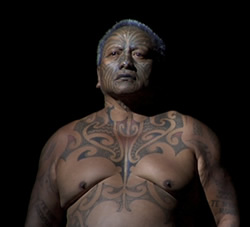 Tempest's reference points are diffuse and often abstract:
Maori struggles, post-9/11 insecurity and attacks on civil rights,
as well as Giogio Agamben's notion of homo sacre (an
individual expelled from social life) and Paul Klee's angelus
novus, all within a stark postlapsarian landscape. The production
began without warning--the noise of an explosion, incredibly loud,
while the lights were still on. A woman with tattered clothing
and small, inadequate, wings walked to edge of the stage and screamed.
It didn't sound like a stage scream. She repeated the scream.
The sound design through many parts was painfully loud. I can't
remember the last time a piece of theater hit me with visceral
fear: probably an elementary school trip to Madison "Scare" Garden.
Many of the other workshop participants concurred, and one added,
"I felt like I was present at something, that I wasn't actually
allowed to see."
Tempest's reference points are diffuse and often abstract:
Maori struggles, post-9/11 insecurity and attacks on civil rights,
as well as Giogio Agamben's notion of homo sacre (an
individual expelled from social life) and Paul Klee's angelus
novus, all within a stark postlapsarian landscape. The production
began without warning--the noise of an explosion, incredibly loud,
while the lights were still on. A woman with tattered clothing
and small, inadequate, wings walked to edge of the stage and screamed.
It didn't sound like a stage scream. She repeated the scream.
The sound design through many parts was painfully loud. I can't
remember the last time a piece of theater hit me with visceral
fear: probably an elementary school trip to Madison "Scare" Garden.
Many of the other workshop participants concurred, and one added,
"I felt like I was present at something, that I wasn't actually
allowed to see."
The production was divided up into episodes,
and the woman returned several times, always screaming. There
were two other homo sacre figures: a dancer pacing on
all fours, and a naked, embryonic man. These individuals were
juxtaposed with rigid monk-like dancers who would always appear
as a ceremonially choreographed group. In contrast to the homo
sacre figures, Tame Iti appeared twice as a figure of strength.
He was incredibly commanding, with tribal tattoos across his chest
and face.
When we fellows discussed this production
as a group, the purple dramaturg began a well-rehearsed complaint:
"This was nothing more than cold, calculated, producer's theater,
designed to turn a profit on the international festival circuit
with some indigenous references and the freak show appeal of a
guy with a tattooed face." A set designer asked the dramaturg
to tell us more about the company and how he knew that it had
been solely designed for the international market. He hesitated,
"well, no, I don't really know anything about the company. But
it's just so obvious."
***
After finishing my undergraduate degree
in New York, I ran off to Berlin to join the theater. I got a
nose ring, took up smoking, and adopted a cat, whom I named after
a Wagner heroine. I was an expatriate, see. Hemingway would have
had something to say about me:
You've lost touch with the soil. You
get precious. Fake European standards have ruined you. You drink
yourself to death. You become obsessed by sex. You spend all
your time talking, not working. You are an expatriate, see.
You hang around cafés.
So perhaps it is partly out of personal
nostalgia that I found the high point of the Edinburgh International
Festival to be Elevator Repair Service's The Sun Also Rises
(The Select). Short of arguing that Paris in the 1920s was
a colony of ex-pat Americans, or that Elevator Repair Service
comes from the former colony of New Amsterdam, it's hard to see
how The Sun Also Rises fit the theme of colonialism.
But it did resonate with my experience of "oceans apart," and
the production was so rich in imagination and humor that for once
I was glad the festival directors didn't take their theme more
seriously.
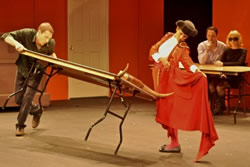 The
Sun Also Rises is Elevator Repair Service's third production
based on American literature of the 1920s. It is not so much a
dramatization of the novela as a staging of it. Mike Iveson plays
Jake Barnes, the narrator of Hemingway's novel. He begins the
play with a long expository passage taken verbatim from chapter
one. Throughout the staging, director John Collins plays with
Barnes' simultaneous roles of narrator and character. At one point,
Barnes shouts, "Why did you do that?!" then immediately drops
his voice: "… I started to say but held back."
The
Sun Also Rises is Elevator Repair Service's third production
based on American literature of the 1920s. It is not so much a
dramatization of the novela as a staging of it. Mike Iveson plays
Jake Barnes, the narrator of Hemingway's novel. He begins the
play with a long expository passage taken verbatim from chapter
one. Throughout the staging, director John Collins plays with
Barnes' simultaneous roles of narrator and character. At one point,
Barnes shouts, "Why did you do that?!" then immediately drops
his voice: "… I started to say but held back."
Elevator Repair Service has a remarkable
ability to introduce slapstick elements that become funnier through
repetition. While the set appeared to be a realistic French brasserie,
the bar top was actually a sound board on which actors controlled
the production's sound design (a running joke of sound effects
that don't completely correlate to staged action). The furniture
of the brasserie was used to enact every episode of the novel;
the tables became trout in one scene, bulls in another.
About two-thirds of the other fellows
left the theater at this show's intermission. When we discussed
the production the following day, I was the only native English
speaker in the room. Of the handful of Germans with varying levels
of English proficiency who condemned the play, not one was willing
to admit that his or her feelings might have something to do with
an inability to understand the nuances of the language. They agreed
that there was simply too much text, rather than that there was
too much text for them to understand. On the one hand, this easy
dismissal of "too much text" speaks to the expectations we have
developed on both sides of the Atlantic that close adherence to
a text is a sign of conservatism and lack of imagination. On the
other hand, this also says a certain amount about general German
condescension vis-à-vis American theater. Among many of the other
fellows, Germany was the only possible reference point for innovative
theater. One German director (who had just finished assisting
Hans Neuenfels in his lab rat production of Lohengrin
in Bayreuth) suggested that Elevator Repair Service was trying
to emulate German Regietheater, but doing it badly. Another
director proclaimed that she wasn't surprised at the play's mediocrity
because "I was in New York twice and I can tell you there is nothing
happening in theater there. I mean, seriously, 0.0 theater." Another
chimed in: "I went there once too, and she's right--there's really
nothing!"
Flying westward that evening, I was relieved
to be returning to my little island without theater. If there
was anything that spending ten long weekends with a roving group
of German critics was good for, it was psychological repatriation.
